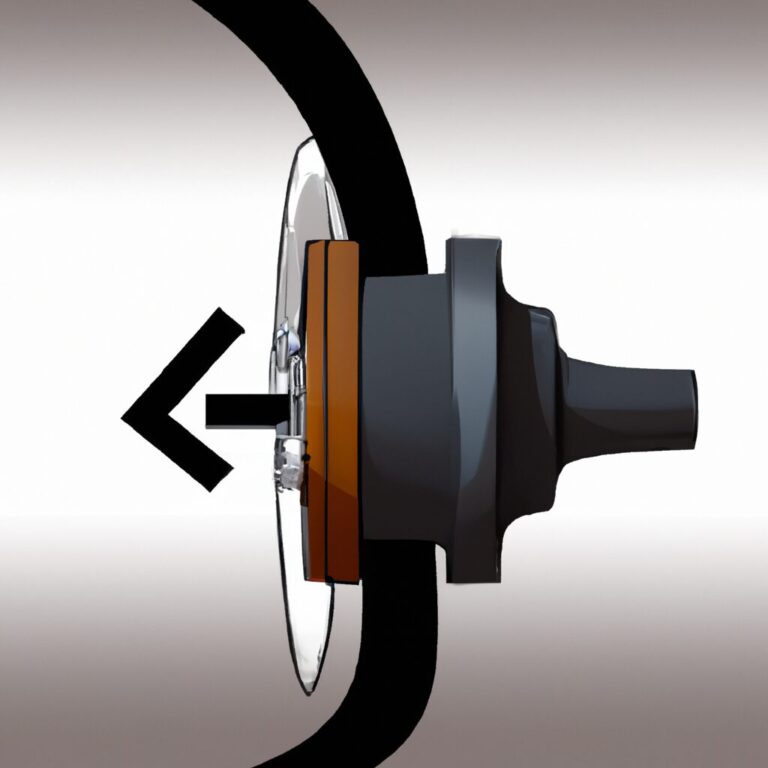How to Read Dipstick
To read a dipstick, pull it out, wipe it clean, reinsert fully, and check oil level. Knowing how to read a dipstick is essential for maintaining proper vehicle oil levels.
By following a few simple steps, you can quickly determine if your engine has enough oil for optimal performance. Taking the time to understand this process can help prevent engine damage and ensure your vehicle runs smoothly. Let’s delve into the specifics of reading a dipstick to empower you with the knowledge needed to properly care for your car’s engine.

Credit: www.machinerylubrication.com
Why Reading Dipstick Is Important
Reading the dipstick is a crucial part of vehicle maintenance, as it provides valuable information about the oil level and quality. By regularly checking the dipstick, you can ensure that your engine is operating smoothly and efficiently, ultimately prolonging its lifespan. Proper maintenance of oil levels also reduces the risk of engine damage and prevents costly repairs. In addition, checking the dipstick is a simple task that can be performed by anyone, making it an essential skill for every vehicle owner.
Ensuring Proper Oil Level
Ensuring proper oil level is essential for the smooth operation of your vehicle’s engine. When the oil level is too low, it can lead to increased friction and heat, potentially causing extensive damage to the engine components. On the other hand, overfilling the oil can also have adverse effects on engine performance. By regularly checking the dipstick, you can ensure that the oil level is within the appropriate range, keeping your engine running smoothly and efficiently.
Checking For Contaminants
Checking for contaminants such as metal shavings, dirt, or sludge in the oil is vital for identifying potential issues within the engine. Contaminants in the oil can indicate wear and tear on engine parts, alerting you to potential problems before they escalate. By regularly inspecting the dipstick for any unusual substances, you can take proactive measures to address any underlying issues, preventing further damage to the engine and ensuring optimal performance.

Credit: www.facebook.com
Step-by-step Guide To Read Dipstick
Park The Vehicle On A Flat Surface
To accurately check the oil level, park the car on a flat surface.
Locate The Dipstick
The dipstick is typically a brightly colored handle that identifies it easily.
Pull Out The Dipstick
Grasp the dipstick firmly, then pull it out of the engine.
Wipe The Dipstick Clean
Use a clean cloth or rag to wipe the oil off the dipstick.
Reinsert The Dipstick
Ensure the dipstick is pushed all the way back in to the engine.
Pull Out The Dipstick Again And Check The Oil Level
Pull out the dipstick for the second time and examine the oil level.
Interpreting Dipstick Readings
Interpreting Dipstick Readings: Understanding how to interpret dipstick readings is crucial in maintaining your vehicle’s engine health.
Checking The Oil Color:
Inspect the oil color on the dipstick. Clean, amber oil signifies it’s in good condition, while black or gritty oil may indicate a need for a change.
Evaluating The Oil Level:
Check the oil level on the dipstick before and after running the engine. The oil level should fall within the designated range for optimal performance.
Common Dipstick Reading Mistakes
Learning how to read a dipstick correctly is crucial, but it’s easy to make common mistakes. Follow these tips to avoid misinterpreting dipstick readings and ensure accurate measurement of oil levels in your vehicle.
Common Dipstick Reading Mistakes Misreading the Oil Level When checking the oil level using a dipstick, it’s crucial to ensure an accurate reading. Many people make the mistake of misinterpreting the dipstick mark. This can lead to overfilling or underfilling the engine oil, resulting in potential damage to the vehicle’s components. To prevent this, be sure to read the dipstick markings carefully and wipe it clean before taking a reading. Avoid rushing, as a moment of patience can save you a lot of trouble in the long run. Not Considering the Oil Color Another common mistake people make when reading a dipstick is overlooking the oil’s color. The color of the oil can provide valuable insight into its condition. For instance, if the oil appears overly dark or contains visible contaminants, it may indicate the need for an oil change or other maintenance. Pay attention to the oil color along with the level to ensure a comprehensive assessment of your engine’s oil condition. By being mindful of these common dipstick reading mistakes, you can ensure that you are accurately gauging the oil level and condition. Proper dipstick readings are essential for maintaining your vehicle’s performance and longevity.When To Read Dipstick
The dipstick is an essential tool for measuring the oil level in your vehicle’s engine. Knowing when to read the dipstick is crucial to maintaining the optimal oil level and ensuring your engine runs smoothly. In this section, we will discuss the recommended frequency for checking the dipstick and identify signs of potential issues that may necessitate a dipstick reading.
Recommended Frequency
It is generally recommended to check your engine’s oil level once a month, or every 3,000 miles, whichever comes first. Regularly monitoring your oil level will help you detect any abnormal changes early on, allowing you to take appropriate action to safeguard your engine’s health. Additionally, if your vehicle has a history of oil consumption issues or if you frequently embark on long trips, more frequent dipstick readings may be necessary.
Signs Of Potential Issues
While the recommended frequency provides a general guideline, it’s crucial to check the dipstick whenever you notice any signs of potential issues. Here are a few indicators that may prompt you to read the dipstick:
- Low Oil Pressure: If your vehicle’s oil pressure warning light illuminates or the oil pressure gauge indicates below-normal levels, it’s essential to check the dipstick immediately. Low oil pressure can lead to engine damage if not addressed promptly.
- Engine Noise: Unusual engine noises, such as knocking or grinding sounds, can be indicative of inadequate lubrication. By reading the dipstick, you can assess whether the oil level is low and take corrective measures.
- Excessive Oil Consumption: If you find yourself needing to refill the oil frequently or notice a sudden decrease in oil levels, it’s important to investigate the cause. A dipstick reading can help determine whether there is a leak or if other issues require attention.
- Erratic Performance: If your engine’s performance becomes inconsistent, such as a loss of power or frequent stalling, it’s worth checking the oil level. Insufficient oil can affect the engine’s functionality and may contribute to these issues.
By being proactive and attentive to signs of potential issues, you can intervene promptly and resolve any oil-related problems before they result in costly repairs or significant engine damage.

Credit: www.reddit.com
Frequently Asked Questions Of How To Read Dipstick
How Do You Read A Dipstick Oil?
To read a dipstick oil, park on a level surface, then remove and wipe the dipstick. Re-insert it fully, then remove again to check the oil level. The level should be between the min and max marks. If it’s low, add more oil as needed.
How Much Oil Should Be On The Dipstick?
Check oil levels when the engine is cool. The oil on the dipstick should be between the minimum and maximum marks.
What Do The Lines On A Dipstick Mean?
The lines on a dipstick indicate oil level, with each line representing a specific measurement for accurate engine oil checking.
What Do Dipstick Marks Mean?
Dipstick marks indicate oil levels in the engine. They show minimum and maximum levels for proper maintenance.
How Do You Read A Dipstick?
To read a dipstick, simply remove it from the engine, wipe it clean, insert it back in, and then remove it again. The oil level should fall between the maximum and minimum markings.
Why Is It Important To Read Your Dipstick?
Reading your dipstick is crucial to maintaining the health of your engine. It allows you to check the oil level and identify any potential issues such as low oil or contamination.
What Does A Low Oil Level On The Dipstick Mean?
A low oil level on the dipstick indicates that your engine is running with insufficient lubrication, which could lead to serious damage if not addressed promptly.
Conclusion
In closing, mastering the art of reading a dipstick is an essential skill for maintaining your vehicle’s health. By paying attention to the intricacies of checking oil levels and understanding the indications on the dipstick, you can ensure your engine operates smoothly and efficiently.
Practicing these steps will help you become more confident in maintaining your car’s proper oil levels.

